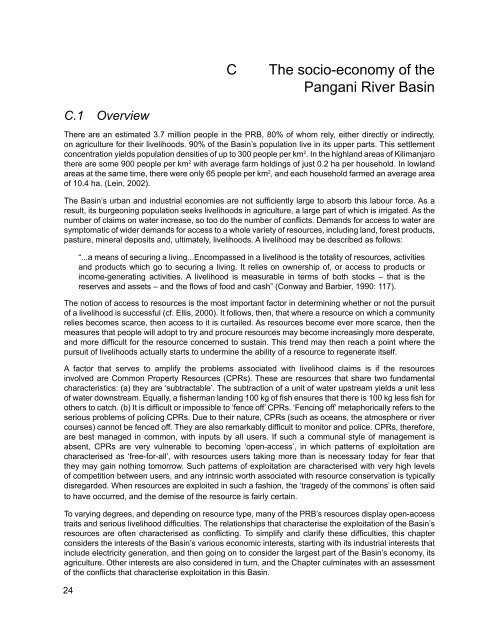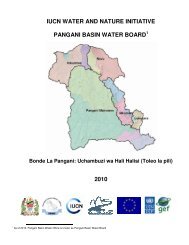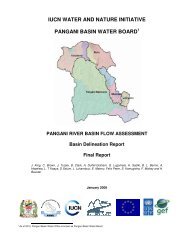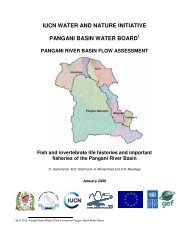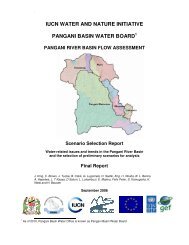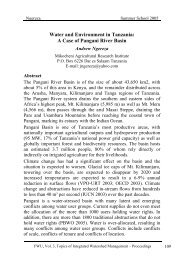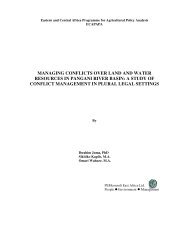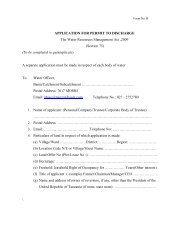PANGANI BASIN WATER BOARD
PANGANI BASIN WATER BOARD
PANGANI BASIN WATER BOARD
Create successful ePaper yourself
Turn your PDF publications into a flip-book with our unique Google optimized e-Paper software.
C The socio-economy of the<br />
Pangani River Basin<br />
C.1 Overview<br />
There are an estimated 3.7 million people in the PRB, 80% of whom rely, either directly or indirectly,<br />
on agriculture for their livelihoods. 90% of the Basin’s population live in its upper parts. This settlement<br />
concentration yields population densities of up to 300 people per km 2 . In the highland areas of Kilimanjaro<br />
there are some 900 people per km 2 with average farm holdings of just 0.2 ha per household. In lowland<br />
areas at the same time, there were only 65 people per km 2 , and each household farmed an average area<br />
of 10.4 ha. (Lein, 2002).<br />
The Basin’s urban and industrial economies are not sufficiently large to absorb this labour force. As a<br />
result, its burgeoning population seeks livelihoods in agriculture, a large part of which is irrigated. As the<br />
number of claims on water increase, so too do the number of conflicts. Demands for access to water are<br />
symptomatic of wider demands for access to a whole variety of resources, including land, forest products,<br />
pasture, mineral deposits and, ultimately, livelihoods. A livelihood may be described as follows:<br />
“...a means of securing a living...Encompassed in a livelihood is the totality of resources, activities<br />
and products which go to securing a living. It relies on ownership of, or access to products or<br />
income-generating activities. A livelihood is measurable in terms of both stocks – that is the<br />
reserves and assets – and the flows of food and cash” (Conway and Barbier, 1990: 117).<br />
The notion of access to resources is the most important factor in determining whether or not the pursuit<br />
of a livelihood is successful (cf. Ellis, 2000). It follows, then, that where a resource on which a community<br />
relies becomes scarce, then access to it is curtailed. As resources become ever more scarce, then the<br />
measures that people will adopt to try and procure resources may become increasingly more desperate,<br />
and more difficult for the resource concerned to sustain. This trend may then reach a point where the<br />
pursuit of livelihoods actually starts to undermine the ability of a resource to regenerate itself.<br />
A factor that serves to amplify the problems associated with livelihood claims is if the resources<br />
involved are Common Property Resources (CPRs). These are resources that share two fundamental<br />
characteristics: (a) they are ‘subtractable’. The subtraction of a unit of water upstream yields a unit less<br />
of water downstream. Equally, a fisherman landing 100 kg of fish ensures that there is 100 kg less fish for<br />
others to catch. (b) It is difficult or impossible to ‘fence off’ CPRs. ‘Fencing off’ metaphorically refers to the<br />
serious problems of policing CPRs. Due to their nature, CPRs (such as oceans, the atmosphere or river<br />
courses) cannot be fenced off. They are also remarkably difficult to monitor and police. CPRs, therefore,<br />
are best managed in common, with inputs by all users. If such a communal style of management is<br />
absent, CPRs are very vulnerable to becoming ‘open-access’, in which patterns of exploitation are<br />
characterised as ‘free-for-all’, with resources users taking more than is necessary today for fear that<br />
they may gain nothing tomorrow. Such patterns of exploitation are characterised with very high levels<br />
of competition between users, and any intrinsic worth associated with resource conservation is typically<br />
disregarded. When resources are exploited in such a fashion, the ‘tragedy of the commons’ is often said<br />
to have occurred, and the demise of the resource is fairly certain.<br />
To varying degrees, and depending on resource type, many of the PRB’s resources display open-access<br />
traits and serious livelihood difficulties. The relationships that characterise the exploitation of the Basin’s<br />
resources are often characterised as conflicting. To simplify and clarify these difficulties, this chapter<br />
considers the interests of the Basin’s various economic interests, starting with its industrial interests that<br />
include electricity generation, and then going on to consider the largest part of the Basin’s economy, its<br />
agriculture. Other interests are also considered in turn, and the Chapter culminates with an assessment<br />
of the conflicts that characterise exploitation in this Basin.<br />
24


